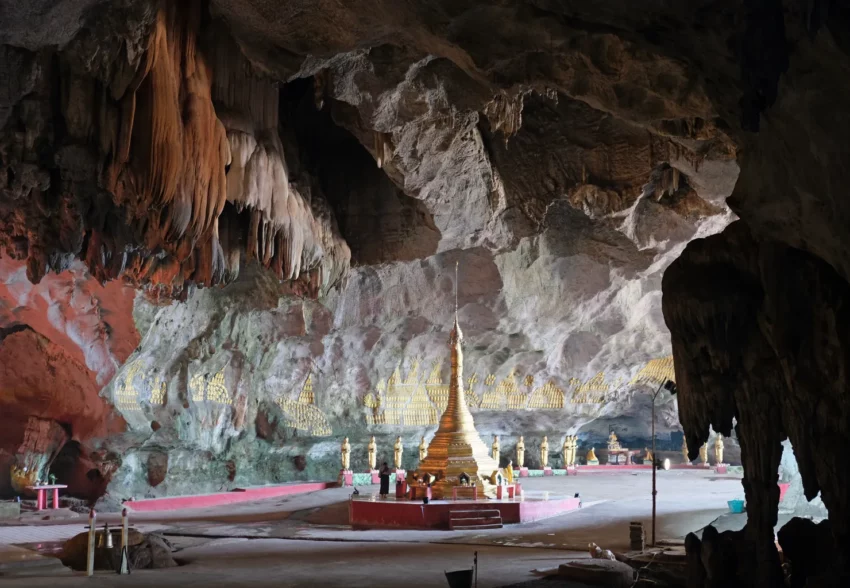Get your dose of History via Email
Saddan Cave: An Overview
The Saddan Cave, located in Myanmar’s Kayin State, is a limestone cave of significant size and biological diversity. Situated near the town of Hpa-an, this natural formation attracts both local and international attention, becoming an important site for tourism in the region. The cave is also of religious significance, evident by the numerous Buddha statues and pagodas found within its expansive interior. Saddan Cave is included in the list of suggested places to visit for those exploring the area around Hpa-an.
The Geography and Accessibility of Saddan Cave
Saddan Cave sits along the eastern bank of the Thanlwin River, also known as the Salween River, which is among the larger water bodies in Myanmar. The landscape surrounding the cave further elevates its allure, with limestone outcroppings and mountainous vistas presenting a dramatic backdrop. The cave entrance, a notable feature in itself, measures approximately 20 meters in height, creating a formidable gateway to the caverns beyond. Visitors can access the cave via the town of Hpa-an, and once within, they can explore on foot or utilize boats for a portion of the journey, providing a distinctive experience alongside the cave’s natural wonder.
The Interior of Saddan Cave
The interior of Saddan Cave is an extensive chamber, with its ceilings reaching heights adequate to accommodate the construction of religious monuments. A path exists that permits visitors to traverse the cave’s length, leading them past an array of stalactites and stalagmites. These calcite formations contribute to the cave’s awe-inspiring atmosphere and underscore the natural processes that shaped the internal landscape over millennia. Throughout the main chamber, Buddha statues adorn the cave in various sizes and poses, underscoring the spiritual significance of the site, particularly for the Theravada Buddhist community. Pagodas and wall carvings related to the Buddhist faith further embellish the cave, creating a serene and reflective environment.
Biological Diversity and Ecological Importance
The cave also serves as a habitat for a variety of species, making it an important ecological site. Bats are among the most prominent inhabitants, taking advantage of the cave’s dark and protected environment. The presence of these creatures underscores the ecological diversity present within this subterranean habitat, which provides a contrasting life zone to the tropical surroundings of Myanmar. The cave’s biodiversity is indicative of the broader environmental richness of the region, highlighting the conservation value Saddan Cave holds within the local ecosystem.
Challenges and Conservation Efforts
While Saddan Cave remains an exquisite example of both geological and biological complexity, its status as a popular tourist attraction has raised concerns regarding conservation. The resultant human traffic and associated impacts on the cave environment necessitate careful management to uphold its natural integrity. Preservation efforts are crucial to maintaining the site for future generations and ensuring that its cultural and ecological legacies persist. The intersection of tourism and conservation presents an ongoing challenge for the stewards of Saddan Cave, as they work to strike a balanced approach between facilitating visitor experiences and safeguarding the cave’s innate characteristics.
Concluding Remarks
In conclusion, Saddan Cave stands as a remarkable natural and cultural landmark in Kayin State, Myanmar. Its combination of significant size, religious importance, and biological diversity contributes to its renown. As a site that both reflects the religious sentiments of the local populace and showcases the splendors of natural limestone formations, Saddan Cave holds particular appeal to those interested in the interplay between geology, ecology, and human spirituality. With appropriate conservation measures, the cave will continue to serve as an invaluable resource for both scientific inquiry and personal enrichment.
Sources:

